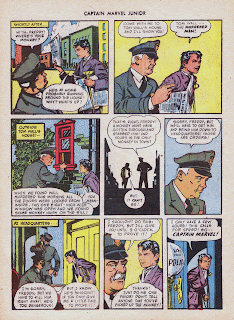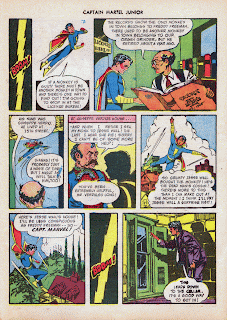The Crime Wave
This story has a sort of odd mixing of different time eras connected to it. Freddy, in then current times (1946), reads an newspaper article about problems in a mining camp (seemly in Alaska or the Yukon). When he arrives to help out in New Town City it seems as if he has gone 50 years into the past to the turn of the 20th Century during the Alaska gold rush days (note the police uniforms- various fashions and town scenes). This sort of "time wrapping" was used in 1950s TV programs like The Roy Rogers Show where Roy and Dale strapped on six shooters to their hips and rode beautiful horses while Pat Brady drove his jeep -Nellybell. As a kid I didn't have a problem with this it just a part of the show. Art by Bud Thompson.
Monday, October 28, 2013
Monday, October 21, 2013
Captain Marvel Jr. #37 (April 1946- The Greybeard!)
The GreyBeard!
Apparently real time exists in Capt. Marvel Jr. stories as Greybeard was convicted in 1846. Since 99 years would have been 1945 from 1846 it seems likely this story was delayed from that year. The art style is anachronistic as three pages use a four-tier panel approach that was more in style in the late 1930s/early 1940s than in the post-war years. The layout and draftsmanship by August Froehlich is markedly different from any of the other stories in the issue. Froehlich obvious copies some of Raboy's poses as he use the same back shot of Cap Jr. in three different panels. Froehlich seems to be one of those artists (at least as far as Captain Marvel Jr. is concerned) who was more of an illustrator and didn't quite understand the dynamics of the panel-to-panel comic strip visual continuity. His work is some of the dullest on the Captain Marvel Jr. strip.
Apparently real time exists in Capt. Marvel Jr. stories as Greybeard was convicted in 1846. Since 99 years would have been 1945 from 1846 it seems likely this story was delayed from that year. The art style is anachronistic as three pages use a four-tier panel approach that was more in style in the late 1930s/early 1940s than in the post-war years. The layout and draftsmanship by August Froehlich is markedly different from any of the other stories in the issue. Froehlich obvious copies some of Raboy's poses as he use the same back shot of Cap Jr. in three different panels. Froehlich seems to be one of those artists (at least as far as Captain Marvel Jr. is concerned) who was more of an illustrator and didn't quite understand the dynamics of the panel-to-panel comic strip visual continuity. His work is some of the dullest on the Captain Marvel Jr. strip.
Monday, October 14, 2013
Captain Marvel Jr. #37 (April 1946, "Sees Stars!")
Sees Stars!
This is a delightful human interest story that shows an infatuated Freddy Freeman being kissed by the beautiful movie star, Lona Twister (Cap Jr. is equally infatuated). Lona Twister seems to be a take off of real life movie star, Lana Turner. However, there are a couple of problems. One, Lona Twister seems not to realize Freddy is the Blue Boy even though he turns into the World's Mightiest Boy in front of her in locked room (Though in the last panel while planting a kiss on Freddy's cheek Miss Twister coyly says, "And this is for your friend Capt. Marvel Jr.! I'll always be indebted to him."). Second, Cap Jr. uses deceit to help the motion picture star succeed with the movie studios. He declares while clobbering the kidnappers with a high heeled shoe, "These high heel marks will convince the reporters. Now, I'd better leave so nobody will suspect I had anything to do with it." Art by Bud Thompson.
This is a delightful human interest story that shows an infatuated Freddy Freeman being kissed by the beautiful movie star, Lona Twister (Cap Jr. is equally infatuated). Lona Twister seems to be a take off of real life movie star, Lana Turner. However, there are a couple of problems. One, Lona Twister seems not to realize Freddy is the Blue Boy even though he turns into the World's Mightiest Boy in front of her in locked room (Though in the last panel while planting a kiss on Freddy's cheek Miss Twister coyly says, "And this is for your friend Capt. Marvel Jr.! I'll always be indebted to him."). Second, Cap Jr. uses deceit to help the motion picture star succeed with the movie studios. He declares while clobbering the kidnappers with a high heeled shoe, "These high heel marks will convince the reporters. Now, I'd better leave so nobody will suspect I had anything to do with it." Art by Bud Thompson.
Monday, October 7, 2013
Captain Marvel Jr. #36 (March 1946, "Monkey Shines! ")
Monkey Shines!
Here we have another POF (Pets of Freddy) story this time with a monkey. An over-aching theme is the naming of the small simian. At the end of the story Freddy calls the monkey, Jeep. He also lists several readers who sent in the right name. While this comic did not have a letters page this acknowledges the importance of its readers and apparently the responsiveness of those readers. Comic book letter columns in the 1940s were a rarity at best. Some of the panels (showing the monkey) could easily have been in a funny animal comic of the period with its animated quality. The artwork (probably) by Bud Thompson shows the his versatility as an artist. He is able to go from realistic draftsmanship to excellent cartoon work. This story has standard copies of Mac Raboy poses for Cap Jr.
Thursday, October 3, 2013
San Diego Comics Fest
I will be at the San Diego Comics Fest this weekend. I will be speaking on the history of American Comics from 1930-1970. Below is the description of my presentation. This will be on Friday night, Oct 4. If you are coming to the Con stop by and say hi.
6:15pm – 7:15pm: The History of American Comic Books, 1930-1970- Don Ensign presents an illustrated history of American comic books, from 1930 through the Silver Age. His presentation begins with the reprint comics of the 1930s, then goes into the rise of Superman and other super heroes. Don discusses the other trends and major companies and personalities of the 1940s. Then he goes into the 1950s with the crime and horror comics and Dr Wertham, followed by the rise of the Silver Age and Marvel Comics and 1960s comics fandom. Panelist: Don Ensign Room: Eaton. - See more at: http://www.sdcomicfest.org/friday-october-4th-programming-schedule/#sthash.q4PBFevR.dpuf
I've also be on a panel late Sunday afternoon.
Don Ensign
6:15pm – 7:15pm: The History of American Comic Books, 1930-1970- Don Ensign presents an illustrated history of American comic books, from 1930 through the Silver Age. His presentation begins with the reprint comics of the 1930s, then goes into the rise of Superman and other super heroes. Don discusses the other trends and major companies and personalities of the 1940s. Then he goes into the 1950s with the crime and horror comics and Dr Wertham, followed by the rise of the Silver Age and Marvel Comics and 1960s comics fandom. Panelist: Don Ensign Room: Eaton. - See more at: http://www.sdcomicfest.org/friday-october-4th-programming-schedule/#sthash.q4PBFevR.dpuf
I've also be on a panel late Sunday afternoon.
Don Ensign
Subscribe to:
Posts (Atom)




























